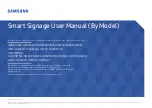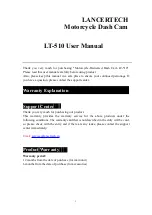
your laptop, a CD-ROM, or other media in case you want to access this reference
when the paper version isn’t handy. If you have an old memory card that’s too small
to be usable on a modern dSLR (I still have some 128MB and 256MB cards), you
can store the PDF on that. But an even better choice is to put the manual on a low-
capacity USB “thumb” drive, which you can buy for less than $10. You’ll then be
able to access the reference anywhere you are, because you can always find some-
one with a computer that has a USB port and Adobe Acrobat Reader available. You
might not be lucky enough to locate a computer with a memory card reader.
■
Pocket guide.
This little booklet tucked away in the camera’s paperwork offers a
reasonable summary of the Canon 60D’s basic commands and settings, and can be
stowed in your camera bag more easily than a “field guide” or even this book.
■
CD-ROMs.
You’ll find the Canon Digital Solution Disk with software applications
(described in Chapter 13), and a Software Instruction manual (in PDF form) on
the pair of CD-ROMs packaged with the camera.
■
Warranty and registration card.
Don’t lose these! You can register your Canon
60D by mail, although you don’t really need to in order to keep your warranty in
force, but you may need the information in this paperwork (plus the purchase
receipt/invoice from your retailer) should you require Canon service support.
Don’t bother rooting around in the box for anything beyond what I’ve listed previously.
There are a few things Canon classifies as optional accessories, even though you (and I)
might consider some of them essential. Here’s a list of what you
don’t
get in the box, but
might want to think about as an impending purchase. I’ll list them roughly in the order
of importance:
■
Memory card.
First-time digital camera buyers are sometimes shocked that their
new tool doesn’t come with a memory card. Why should it? The manufacturer
doesn’t have the slightest idea of how much storage you require, or whether you
want a slow/inexpensive card or one that’s faster/more expensive, so why should
they pack one in the box and charge you for it? For an 18-megapixel camera, you
really need one that’s a minimum of 8GB in size.
■
Extra LP-E6 battery.
Even though you might get 500 to more than 1,000 shots
from a single battery, it’s easy to exceed that figure in a few hours of shooting sports
at 8 fps. Batteries can unexpectedly fail, too, or simply lose their charge from sit-
ting around unused for a week or two. Buy an extra (I own four, in total), keep it
charged, and free your mind from worry. This is the same battery used in the EOS
5D Mark II.
■
Add-on Speedlite.
One of the best uses for your Canon 60D’s built-in electronic
flash is as a remote trigger for an off-camera Speedlite such as the Canon 580EX II,
which was designed especially for cameras in this class. Your built-in flash can
David Busch’s Canon EOS 60D Guide to Digital SLR Photography
10
Copyright 2011 Cengage Learning. All Rights Reserved. May not be copied, scanned, or duplicated, in whole or in part. Due to electronic rights, some third party content may be suppressed from the eBook and/or eChapter(s).
Editorial review has deemed that any suppressed content does not materially affect the overall learning experience. Cengage Learning reserves the right to remove additional content at any time if subsequent rights restrictions require it.
Licensed to:
Содержание EOS 60D
Страница 1: ...Licensed to...












































